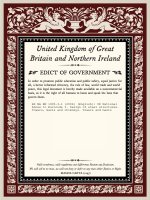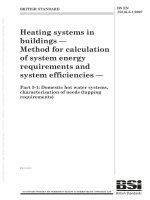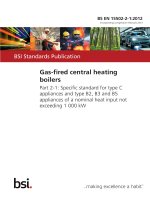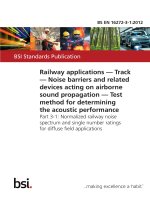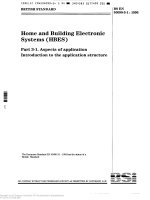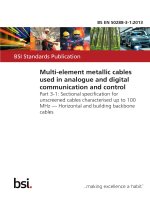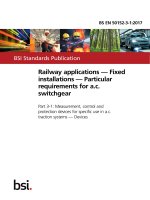Bsi bs en 61375 3 1 2012
Bạn đang xem bản rút gọn của tài liệu. Xem và tải ngay bản đầy đủ của tài liệu tại đây (1.71 MB, 134 trang )
BS EN 61375-3-1:2012
BSI Standards Publication
Electronic railway equipment
— Train communication
network (TCN)
Part 3-1: Multifunction Vehicle Bus (MVB)
BS EN 61375-3-1:2012 BRITISH STANDARD
National foreword
This British Standard is the UK implementation of EN 61375-3-1:2012.
It is identical to IEC 61375-3-1:2012.
The UK participation in its preparation was entrusted by Technical Committee
GEL/9, Railway Electrotechnical Applications, to Panel GEL/9/-/4, Railway
applications - Train communication network and multimedia systems.
A list of organizations represented on this committee can be obtained on
request to its secretary.
This publication does not purport to include all the necessary provisions of a
contract. Users are responsible for its correct application.
© The British Standards Institution 2012
Published by BSI Standards Limited 2012
ISBN 978 0 580 68229 2
ICS 45.060
Compliance with a British Standard cannot confer immunity
from legal obligations.
This British Standard was published under the authority of the
Standards Policy and Strategy Committee on 31 August 2012.
Amendments issued since publication
Amd. No. Date Text affected
EUROPEAN STANDARD BS EN 61375-3-1:2012
NORME EUROPÉENNE
EUROPÄISCHE NORM EN 61375-3-1
ICS 45.060 August 2012
English version
Electronic railway equipment -
Train communication network (TCN) -
Part 3-1: Multifunction Vehicle Bus (MVB)
(IEC 61375-3-1:2012)
Matériel électronique ferroviaire - Elektronische Betriebsmittel für Bahnen -
Réseau embarqué de train (TCN) - Zug-Kommunikations-Netzwerk -
Partie 3-1: Bus de Véhicule Multifonctions Teil 3-1: Multipurpose Vehicle Bus (MVB)
(MVB) (IEC 61375-3-1:2012)
(CEI 61375-3-1:2012)
This European Standard was approved by CENELEC on 2012-07-26. CENELEC members are bound to comply
with the CEN/CENELEC Internal Regulations which stipulate the conditions for giving this European Standard
the status of a national standard without any alteration.
Up-to-date lists and bibliographical references concerning such national standards may be obtained on
application to the CEN-CENELEC Management Centre or to any CENELEC member.
This European Standard exists in three official versions (English, French, German). A version in any other
language made by translation under the responsibility of a CENELEC member into its own language and notified
to the CEN-CENELEC Management Centre has the same status as the official versions.
CENELEC members are the national electrotechnical committees of Austria, Belgium, Bulgaria, Croatia, Cyprus,
the Czech Republic, Denmark, Estonia, Finland, Former Yugoslav Republic of Macedonia, France, Germany,
Greece, Hungary, Iceland, Ireland, Italy, Latvia, Lithuania, Luxembourg, Malta, the Netherlands, Norway, Poland,
Portugal, Romania, Slovakia, Slovenia, Spain, Sweden, Switzerland, Turkey and the United Kingdom.
CENELEC
European Committee for Electrotechnical Standardization
Comité Européen de Normalisation Electrotechnique
Europäisches Komitee für Elektrotechnische Normung
Management Centre: Avenue Marnix 17, B - 1000 Brussels
© 2012 CENELEC - All rights of exploitation in any form and by any means reserved worldwide for CENELEC members.
Ref. No. EN 61375-3-1:2012 E
BS EN 61375-3-1:2012
EN 61375-3-1:2012
Foreword
The text of document 9/1644/FDIS, future edition 1 of IEC 61375-3-1, prepared by IEC/TC 9 "Electrical
equipment and systems for railways" was submitted to the IEC-CENELEC parallel vote and approved by
CENELEC as EN 61375-3-1:2012.
The following dates are fixed: (dop) 2013-04-26
(dow) 2015-07-26
• latest date by which the document has
to be implemented at national level by
publication of an identical national
standard or by endorsement
• latest date by which the national
standards conflicting with the
document have to be withdrawn
Attention is drawn to the possibility that some of the elements of this document may be the subject of
patent rights. CENELEC [and/or CEN] shall not be held responsible for identifying any or all such patent
rights.
This document has been prepared under a mandate given to CENELEC by the European Commission
and the European Free Trade Association, and supports essential requirements of EU Directive(s).
For the relationship with EU Directive(s) see informative Annex ZZ, which is an integral part of this
document.
Endorsement notice
The text of the International Standard IEC 61375-3-1:2012 was approved by CENELEC as a European
Standard without any modification.
In the official version, for Bibliography, the following notes have to be added for the standards indicated:
IEC 60332-1-2 NOTE Harmonized as EN 60332-1-2.
IEC 60870 series NOTE Harmonized in EN 60870 series.
IEC 61158-2 NOTE Harmonized as EN 61158-2.
BS EN 61375-3-1:2012
EN 61375-3-1:2012
Annex ZA
(normative)
Normative references to international publications
with their corresponding European publications
The following documents, in whole or in part, are normatively referenced in this document and are
indispensable for its application. For dated references, only the edition cited applies. For undated
references, the latest edition of the referenced document (including any amendments) applies.
NOTE When an international publication has been modified by common modifications, indicated by (mod), the relevant EN/HD
applies.
Publication Year Title EN/HD Year
IEC 60245-1 - -
IEC 60304 - Rubber insulated cables - Rated voltages up - -
IEC 60332-1-1 - to and including 450/750 V - -
Part 1: General requirements
IEC 60571 - -
IEC 60794-1-1 - Standard colours for insulation for low- HD 402 S2 -
IEC 60807 Series frequency cables and wires -
IEC 60870-5-1 - -
IEC 61375-2-1 - Tests on electric and optical fibre cables EN 60332-1-1 -
ISO/IEC 8482 - -
ISO/IEC 8802-2 - under fire conditions - -
ISO/IEC 8824 Series Part 1-1: Test for vertical flame propagation -
ISO/IEC 8825 Series -
ISO/IEC 9646 Series for a single insulated wire or cable - Apparatus -
ISO/IEC 13239 - -
Electronic equipment used on rail vehicles -
Optical fibre cables - EN 60794-1-1
Part 1-1: Generic specification - General
Rectangular connectors for frequencies below -
3 MHz
Telecontrol equipment and systems - EN 60870-5-1
Part 5: Transmission protocols - Section 1:
Transmission frame formats
Electronic railway equipment - Train EN 61375-2-1
communication network (TCN) -
Part 2-1: Wire Train Bus (WTB)
Information technology - Telecommunications -
and information exchange between systems -
Twisted pair multipoint interconnections
Information technology - Telecommunications -
and information exchange between systems -
Local and metropolitan area networks -
Specific requirements -
Part 2: Logical link control
Information technology - Abstract Syntax -
Notation One (ASN.1)
Information technology - ASN.1 encoding -
rules
Information technology - Open Systems -
Interconnection - Conformance testing
methodology and framework
Information technology - Telecommunications -
and information exchange between systems -
High-level data link control (HDLC)
procedures
BS EN 61375-3-1:2012
EN 61375-3-1:2012
Publication Year Title EN/HD Year
- -
ITU-T Specification and Description Language (SDL)-
Recommendation
Z.100
BS EN 61375-3-1:2012
EN 61375-3-1:2012
Annex ZZ
(informative)
Coverage of Essential Requirements of EU Directives
This European Standard has been prepared under a mandate given to CENELEC by the
European Commission and the European Free Trade Association and within its scope the
standard covers all relevant essential requirements as given in Annex III of the EU Directive
2008/57/EC.
Compliance with this standard provides one means of conformity with the specified essential
requirements of the Directive concerned.
WARNING: Other requirements and other EU Directives may be applicable to the products
falling within the scope of this standard.
BS EN 61375-3-1:2012
61375-3-1 Ô IEC:2012
CONTENTS
INTRODUCTION . ................................................................................................................................ 10
1 Scope . ........................................................................................................................................... 12
2 Normative references. ................................................................................................................. 12
3 Terms and definitions, abbreviations and conventions . .......................................................... 13
3.1 Terms and definitions . ...................................................................................................... 13
3.2 Abbreviations...................................................................................................................... 30
3.3 Conventions ....................................................................................................................... 31
3.3.1 Base of numeric values . ...................................................................................... 31
3.3.2 Naming conventions. ............................................................................................ 32
3.3.3 Time naming conventions ................................................................................... 32
3.3.4 Procedural interface conventions . ..................................................................... 32
3.3.5 Specification of transmitted data . ...................................................................... 35
3.3.6 State diagram conventions . ................................................................................ 37
4 Physical Layer . ............................................................................................................................ 38
4.1 Topology . ........................................................................................................................... 38
4.1.1 Segments .............................................................................................................. 38
4.1.2 Couplers . ............................................................................................................... 38
4.1.3 Double-line segments . ........................................................................................ 39
4.2 Device classes . ................................................................................................................. 39
4.2.1 Capabilities . .......................................................................................................... 39
4.2.2 Class 0 devices . .................................................................................................. 40
4.2.3 Class 1 devices . .................................................................................................. 40
4.2.4 Class 2 devices . .................................................................................................. 40
4.2.5 Class 3 devices . .................................................................................................. 40
4.2.6 Class 4 devices . .................................................................................................. 40
4.2.7 Class 5 devices . .................................................................................................. 40
4.2.8 Device Attachment . .............................................................................................. 41
4.3 Specifications common to all media . .............................................................................. 41
4.3.1 Signalling speed . ................................................................................................. 41
4.3.2 Propagation delays . ............................................................................................. 41
4.3.3 Transceiver interface ........................................................................................... 41
4.3.4 Redundant medium (option) . .............................................................................. 42
4.4 Electrical Short Distance medium (choice) . ................................................................... 43
4.4.1 ESD topology. ....................................................................................................... 43
4.4.2 ESD configuration rules . ..................................................................................... 44
4.4.3 ESD section specifications .................................................................................. 45
4.4.4 ESD shielding . ...................................................................................................... 45
4.4.5 ESD medium-dependent interface . .................................................................... 46
4.4.6 ESD Line_Unit specifications . ............................................................................ 48
4.4.7 ESD signal wave form . ........................................................................................ 48
4.4.8 ESD transmitter .................................................................................................... 49
4.4.9 ESD receiver . ....................................................................................................... 50
4.5 Electrical Middle Distance medium (choice) .................................................................. 51
4.5.1 EMD topology . ...................................................................................................... 51
4.5.2 EMD configuration rules . ..................................................................................... 51
BS EN 61375-3-1:2012
61375-3-1 Ô IEC:2012
4.5.3 EMD terminator..................................................................................................... 52
4.5.4 Cable section. ....................................................................................................... 52
4.5.5 EMD shielding. ...................................................................................................... 53
4.5.6 EMD medium-dependent interface . ................................................................... 54
4.5.7 EMD Line_Unit specifications . ............................................................................ 57
4.5.8 EMD signal waveform . ........................................................................................ 58
4.5.9 EMD transmitter specifications . .......................................................................... 58
4.5.10 EMD receiver specifications . .............................................................................. 62
4.6 Optical Glass Fibre medium (choice). ............................................................................. 63
4.6.1 OGF topology . ...................................................................................................... 64
4.6.2 OGF optical cable and fibre. ............................................................................... 64
4.6.3 OGF medium-dependent interface . ................................................................... 64
4.6.4 OGF test signal (guideline) . ............................................................................... 65
4.6.5 OGF transmitter specifications ........................................................................... 66
4.6.6 OGF receiver specifications . .............................................................................. 66
4.6.7 OGF active star coupler . ..................................................................................... 67
4.6.8 OGF double-line layout (option).......................................................................... 68
5 Medium-dependent signalling ..................................................................................................... 68
5.1 Frame encoding and decoding . ....................................................................................... 68
5.1.1 Conventions. ......................................................................................................... 68
5.1.2 Bit encoding. ......................................................................................................... 69
5.1.3 Non-data symbols . ............................................................................................... 69
5.1.4 Start Bit . ................................................................................................................ 69
5.1.5 Start Delimiter. ...................................................................................................... 69
5.1.6 End Delimiter . ....................................................................................................... 70
5.1.7 Valid frame (definition) . ....................................................................................... 71
5.1.8 Detection of line idle ............................................................................................ 71
5.1.9 Detection of collision ............................................................................................ 71
5.1.10 Receiver behaviour in case of error . .................................................................. 71
5.1.11 Jabber halt . .......................................................................................................... 71
5.2 Line redundancy (option) . ................................................................................................ 72
5.2.1 Principle . ............................................................................................................... 72
5.2.2 Redundant transmission. ..................................................................................... 72
5.2.3 Redundant reception ............................................................................................ 72
5.2.4 Switchover .............................................................................................................72
5.2.5 Redundancy status report ................................................................................... 73
5.3 Repeater . ...........................................................................................................................73
5.3.1 Repeater between single-line segments . .......................................................... 74
5.3.2 Repeater for redundant medium (option) . ......................................................... 74
6 Frames and telegrams . ............................................................................................................... 75
6.1 Frame format...................................................................................................................... 75
6.1.1 Master Frame format ........................................................................................... 75
6.1.2 Slave Frame format . ............................................................................................ 75
6.1.3 Check Sequence. ................................................................................................. 76
6.2 Telegram timing. ................................................................................................................ 77
6.2.1 Conventions. ......................................................................................................... 77
6.2.2 Reply delay (definition). ....................................................................................... 77
6.2.3 Frame spacing at the source . ............................................................................. 79
6.2.4 Frame spacing at the destination. ...................................................................... 79
BS EN 61375-3-1:2012
61375-3-1 Ô IEC:2012
6.2.5 Frame spacing at the master. ............................................................................. 80
6.3 Detection of correct frames, collision and silence by the master . ............................... 81
6.3.1 Correct frame (definition) .................................................................................... 81
6.3.2 Detection of collision by the master . .................................................................. 81
6.3.3 Detection of silence by the master. .................................................................... 81
7 Link Layer Control. ....................................................................................................................... 81
7.1 Addressing . ........................................................................................................................ 81
7.1.1 Device Address. .................................................................................................... 81
7.1.2 Logical_Address . ................................................................................................. 81
7.1.3 Group_Address..................................................................................................... 82
7.2 Master Frames contents . ................................................................................................. 82
7.2.1 Master Frame format ........................................................................................... 82
7.2.2 F_code encoding . ................................................................................................ 82
7.3 Slave Frame contents . ...................................................................................................... 83
7.3.1 Slave Frame format . ............................................................................................ 83
7.3.2 Size error. .............................................................................................................. 84
7.4 Telegram types . ................................................................................................................. 84
7.4.1 Process Data telegram. ....................................................................................... 84
7.4.2 Message Data. ...................................................................................................... 85
7.4.3 Supervisory Data telegrams . .............................................................................. 86
8 Medium allocation . ....................................................................................................................... 87
8.1 Organisation ....................................................................................................................... 87
8.1.1 Turn . ...................................................................................................................... 87
8.1.2 Basic Period . ........................................................................................................ 87
8.1.3 Padding . ................................................................................................................ 88
8.2 Periodic Polling. ................................................................................................................. 88
8.2.1 Periodic List. ......................................................................................................... 88
8.2.2 Individual Period . ................................................................................................. 88
8.2.3 Periodic Phase construction . .............................................................................. 89
8.3 Event Polling ...................................................................................................................... 90
8.3.1 Group_Address..................................................................................................... 90
8.3.2 Event_Round . ....................................................................................................... 91
8.3.3 Recommended event search algorithm . ............................................................ 93
8.3.4 Supervisory Data frames for Event_Arbitration ................................................ 94
8.4 Devices_Scan..................................................................................................................... 96
8.4.1 Device_Status . ..................................................................................................... 96
8.4.2 Device_Status protocol . ...................................................................................... 98
8.4.3 Devices_Scan protocol . ...................................................................................... 99
9 Mastership transfer ...................................................................................................................... 99
9.1 Mastership transfer operation . ........................................................................................ 99
9.1.1 Bus administrator configuration .......................................................................... 99
9.2 Mastership transfer specifications . ............................................................................... 100
9.2.1 States . ................................................................................................................. 100
9.2.2 Time-outs for mastership transfer . .................................................................. 103
9.3 Supervisory data frames for mastership transfer ........................................................ 103
9.3.1 Device_Status telegram . ................................................................................... 103
9.3.2 Mastership transfer telegram. ........................................................................... 104
10 Link Layer Interface . ................................................................................................................. 104
10.1 Link Layer layering. ......................................................................................................... 104
BS EN 61375-3-1:2012
61375-3-1 Ô IEC:2012
10.2 Link Process Data interface . ......................................................................................... 105
10.3 Link Message Data interface. ........................................................................................ 105
10.3.1 General . .............................................................................................................. 105
10.3.2 Priority. ................................................................................................................ 106
10.3.3 Packet size . ........................................................................................................ 106
10.3.4 Protocol_Type..................................................................................................... 106
10.3.5 Message Transport Protocol . ........................................................................... 106
10.4 Link Supervision Interface. ............................................................................................. 106
10.4.1 General . .............................................................................................................. 106
10.4.2 Link Supervision Interface procedures. ........................................................... 106
10.4.3 MVB_Status. ....................................................................................................... 107
10.4.4 MVB_Control . ..................................................................................................... 107
10.4.5 MVB_Devices ..................................................................................................... 108
10.4.6 MVB_Administrator ............................................................................................ 108
10.4.7 MVB_Report . ...................................................................................................... 110
11 Real-Time Protocols . ................................................................................................................ 111
12 Gateway Function ...................................................................................................................... 111
13 Network Management . .............................................................................................................. 111
13.1 Contents of this clause . ................................................................................................. 111
13.2 MVB Managed objects .................................................................................................... 111
13.2.1 MVB link objects . ............................................................................................... 111
13.3 MVB Services and management messages ................................................................. 112
13.3.1 MVB link services . ............................................................................................. 112
Bibliography . ..................................................................................................................................... 126
Figure 1 – Reference device and structure of the document ......................................................... 11
Figure 2 – State transition example . ................................................................................................ 37
Figure 3 – MVB configuration . .......................................................................................................... 39
Figure 4 – Transceiver interface . ...................................................................................................... 42
Figure 5 – Example of ESD segment . .............................................................................................. 43
Figure 6 – Example of terminator. ..................................................................................................... 44
Figure 7 – ESD backplane section (double-line). ............................................................................ 46
Figure 8 – ESD connector arrangement . ......................................................................................... 47
Figure 9 – ESD terminator connector arrangement . ...................................................................... 48
Figure 10 – Example of start of frame (ESD) . ................................................................................ 49
Figure 11 – End of an ESD frame (both cases) . ............................................................................. 50
Figure 12 – EMD medium . ................................................................................................................. 51
Figure 13 – Shielding (single-line segment) . ................................................................................... 53
Figure 14 – Single-line device attachment . ..................................................................................... 54
Figure 15 – Double-line device attachment to EMD . ...................................................................... 55
Figure 16 – EMD connectors arrangement . ..................................................................................... 56
Figure 17 – EMD terminator strapping . ............................................................................................ 57
Figure 18 – Example of start of an EMD frame . ............................................................................. 58
Figure 19 – Example of pulse waveform at EMD transmitter ........................................................ 60
Figure 20 – Example of end of EMD frame . .................................................................................... 61
Figure 21 – EMD receiver test signal . .............................................................................................. 62
BS EN 61375-3-1:2012
61375-3-1 Ô IEC:2012
Figure 22 Optical link . .................................................................................................................... 64
Figure 23 – Optical connector (dimensions in millimeters). ........................................................... 65
Figure 24 – Example of start of OGF frame . ................................................................................... 66
Figure 25 – Edge jitter ........................................................................................................................ 67
Figure 26 – Example of active star coupler . .................................................................................... 67
Figure 27 – Example of a duplicated star coupler. .......................................................................... 68
Figure 28 – "0" and "1" data encoding. ............................................................................................. 69
Figure 29 – Non_Data symbols encoding . ....................................................................................... 69
Figure 30 – Master Start Delimiter . .................................................................................................. 70
Figure 31 – Slave Start Delimiter . ..................................................................................................... 70
Figure 32 – Example of End Delimiter for EMD medium . .............................................................. 70
Figure 33 – Example of a valid frame (OGF medium). ................................................................... 71
Figure 34 – Signal skew . ................................................................................................................... 72
Figure 35 – Example of repeater for single-line attachment. ......................................................... 74
Figure 36 – Example of repeater connecting a double-line to a single line segment . ................75
Figure 37 – Master Frame Format .................................................................................................... 75
Figure 38 – Slave Frames . ................................................................................................................ 76
Figure 39 – Telegram timing.............................................................................................................. 77
Figure 40 – Example of Reply delay. ................................................................................................ 78
Figure 41 – Frame spacing at the source side . .............................................................................. 79
Figure 42 – Frame spacing at the destination(s) . ........................................................................... 79
Figure 43 – Frame spacing at the master side . .............................................................................. 80
Figure 44 – Master Frame contents . ................................................................................................ 82
Figure 45 – Word ordering in a Slave Frame. .................................................................................. 84
Figure 46 – Process Data telegram . ................................................................................................ 84
Figure 47 – Message Data telegram . ............................................................................................... 85
Figure 48 – Supervisory Data telegram ............................................................................................ 86
Figure 49 – Basic Periods . ................................................................................................................ 87
Figure 50 – Example of construction of the Macro_Cycle . ............................................................ 90
Figure 51 – General_Event_Request frame format . ...................................................................... 94
Figure 52 – Group_Event_Request frame (M = 6, C = ABCDEF) . ................................................ 94
Figure 53 – Single_Event_Request frame . ...................................................................................... 95
Figure 54 – Event_Identifier_Response frame . .............................................................................. 95
Figure 55 – Device_Status_Request . ............................................................................................... 96
Figure 56 – Device_Status_Response . ............................................................................................ 96
Figure 57 – Device_Status of Class 1 device . ................................................................................ 97
Figure 58 – Device_Status of Class 2/3/4/5 device . ...................................................................... 97
Figure 59 – Device_Status of a device with Bus Administrator capability . .................................. 97
Figure 60 – Device_Status of a device with Gateway capability . .................................................. 98
Figure 61 – Mastership Transfer states . ....................................................................................... 102
Figure 62 – Device_Status_Request (sent by current master) . .................................................. 103
Figure 63 – Device_Status_Response (sent by proposed master) . ........................................... 103
Figure 64 – Mastership_Transfer_Request (sent by current master). ........................................ 104
BS EN 61375-3-1:2012
61375-3-1 Ô IEC:2012
Figure 65 Mastership_Transfer_Response (sent by proposed next master) . ........................ 104
Figure 66 – Link Layer Layering. ..................................................................................................... 105
Table 1 – Template for the specification of an interface procedure . ............................................ 34
Table 2 – Example of message structure . ....................................................................................... 35
Table 3 – Example of textual message form (corresponding to Table 2) . ...................................36
Table 4 – State transitions table . ...................................................................................................... 37
Table 5 – MVB devices capabilities . ................................................................................................ 40
Table 6 – Pin assignment for the ESD connector ........................................................................... 47
Table 7 – Pin assignment for the EMD connector. .......................................................................... 56
Table 8 – Master Frame types and F_code . .................................................................................... 83
Table 9 – LS_RESULT encoding .................................................................................................... 107
Table 10 – MVB_Status object . ...................................................................................................... 107
Table 11 – MVB_Control object . ..................................................................................................... 108
Table 12 – MVB_Devices object ..................................................................................................... 108
Table 13 – MVB_Administrator object ............................................................................................ 109
Table 14 – LS_V_REPORT encoding. ............................................................................................ 111
Table 15 – Example of mvb_administrator_list . ............................................................................ 123
– 10 – BS EN 61375-3-1:2012
61375-3-1 Ô IEC:2012
INTRODUCTION
This part of IEC 61375 specifies one component of the Train Communication Network, the
Multifunction Vehicle Bus (MVB), a serial data communication bus designed primarily, but not
exclusively, for interconnecting equipment where interoperability and interchangeability are
needed.
This part specifies:
a) the physical media in single-line and double-line configurations;
b) the signalling and the redundancy handling;
c) the format and timing of the transmitted frame and telegrams;
d) the organisation of the bus traffic;
e) the allocation of Mastership;
f) the management of the bus;
g) the Link Layer interface and the layer management interface.
This part is structured following the OSI layers of a reference MVB device as shown in
Figure 1:
Caluse 4 Physical Layer
x Electrical medium for short distance (RS-485, 20,0 m)
x Electrical medium for middle distance (transformer-coupled, 200,0 m)
x Optical fibre for long distances (glass fibres, 2,0 km)
Clause 5 Medium-dependent signalling
x Frame encoding and decoding
x Line Unit interface
x Physical redundancy handling
Clause 6 Frames and telegrams
x Master Frame and Slave Frame encoding, Telegram timing
Clause 7 Link Layer Control
x Addressing
x Master Frame and Slave Frame format
Clause 8 Medium allocation
x Periodic Polling
x Event Polling
x Devices Scan
Clause 9 Mastership transfer
x Regular and exceptional mastership transfer
Clause 10 Link Layer Interface
x Link Process Data Interface (LPI),
x Link Message Data Interface (LMI),
x Link Supervision Interface (LSI).
Clause 11 Real-Time Protocols
Clause 12 Gateway Function
Clause 13 Network Management
BS EN 61375-3-1:2012 – 11
61375-3-1 Ô IEC:2012
Clause Real-Time Station
link layer interface Protocols management
10 LPI LMI LSI
9 link layer adapter layer
management
mastership transfer
8 medium allocation
periodic, event, supervisory scan
7 frame formats and content link control
6 coding, timing and synchronisation frames and telegrams
medium attachment unit interface
redundancy handling
line unit interface
5
signalling signalling
frame encoder / decoder frame encoder / decoder
transceiver interface redundant line
(optional)
4 Electrical_Short_ Electrical_Middle_ Optical_Glass_
Distance (ESD) Distance (EMD) Fibre (OGF)
Physical Layer
Figure 1 – Reference device and structure of the document
– 12 – BS EN 61375-3-1:2012
61375-3-1 Ô IEC:2012
ELECTRONIC RAILWAY EQUIPMENT –
TRAIN COMMUNICATION NETWORK (TCN) –
Part 3-1: Multifunction Vehicle Bus (MVB)
1 Scope
This part of IEC 61375 applies where MVB is required.
2 Normative references
The following documents, in whole or in part, are normatively referenced in this document and
are indispensable for its application. For dated references, only the edition cited applies. For
undated references, the latest edition of the referenced document (including any amendments)
applies.
IEC 60245-1, Rubber insulated cables – Rated voltages up to and including 450/750 V – Part 1:
General requirements
IEC 60304, Standard colours for insulation for low-frequency cables and wires
IEC 60332-1-1, Tests on electric and optical fibre cables under fire conditions – Part 1-1: Test
for vertical flame propagation for a single insulated wire or cable – Apparatus
IEC 60571, Electronic equipment used on rail vehicles
IEC 60794-1-1, Optical fibre cables – Part 1-1: Generic specification – General
IEC 60807 (all parts), Rectangular connectors for frequencies below 3 MHz
IEC 60870-5-1, Telecontrol equipment and systems – Part 5: Transmission protocols – Section
One: Transmission frame formats
IEC 61375-2-1, Electronic railway equipment – Train Communication Network (TCN) –
Part 2-1: Wire Train Bus (WTB)
ISO/IEC 8482, Information technology – Telecommunications and information exchange
between systems – Twisted pair multipoint interconnections
ISO/IEC 8802-2, Information technology – Telecommunications and information exchange
between systems – Local and metropolitan area networks – Specific requirements – Part 2:
Logical link control
ISO/IEC 8824 (all parts), Information technology – Abstract Syntax Notation One (ASN.1)
ISO/IEC 8825 (all parts), Information technology – ASN.1 encoding rules
ISO/IEC 9646 (all parts), Information technology – Open Systems Interconnection –
Conformance testing methodology and framework
BS EN 61375-3-1:2012 13
61375-3-1 Ô IEC:2012
ISO/IEC 13239, Information technology – Telecommunications and information exchange
between systems – High-level data link control (HDLC) procedures
ITU-T Recommendation Z.100, Specification and Description Language (SDL)
3 Terms and definitions, abbreviations and conventions
3.1 Terms and definitions
For the purposes of this document, the following terms and definitions apply.
NOTE Keywords in this standard are written with the first letter of each word in upper case and, when they are
composed of two or several words, these are joined by an underscore. This convention allows keywords to be
tracked in the documents.
3.1.1
address
identifier of a communication partner, of which several types exist, depending on the layer
3.1.2
agent
application process in a Station which accesses the local managed objects on behalf of the
Manager
3.1.3
Aperiodic Data
transmission of Process Data on a demand basis. This service is not used
3.1.4
Application Layer
upper layer in the OSI model, interfacing directly to the Application
3.1.5
Application Layer Interface
definition of the services offered by the Application Layer
3.1.6
Application Messages Adapter
code directly called by the application implementing the Messages services
3.1.7
Application Messages Interface
definition of the Messages services
3.1.8
Application Process
communicating entity, implemented for instance by a task
3.1.9
Application Processor
processor which runs a communicating Application Process
3.1.10
Application Supervision Interface
definition of the Supervision services available in particular to the Agent
– 14 – BS EN 61375-3-1:2012
61375-3-1 Ô IEC:2012
3.1.11
Application Variables Adapter
code directly called by the application implementing the Variables services
3.1.12
Application Variables Interface
definition of the Variables services
3.1.13
arbiter
device, or common protocol followed by several devices, which selects one of several devices
competing for mastership
3.1.14
Auxiliary Channel
channel used for detecting additional Nodes
3.1.15
Basic Period
bus activity is divided into periods. The shortest is the Basic Period, which consists of a
Periodic Phase (for Periodic Data) and of a Sporadic Phase (for Message Data and
Supervisory Data)
3.1.16
big-endian
ordering scheme for storing or transmitting data in which the most significant part of a multiple-
octet data is stored at the lowest octet address, and transmitted first
3.1.17
bit-stuffing
method specified by ISO/IEC 13239 to prevent Frame Data from being misinterpreted as a
Flag, consisting of inserting an additional "0" symbol after each string of five "1" symbols and
removing this "0" at reception
3.1.18
bridge
device which stores and forwards frames from one bus to another on the base of their Link
Layer addresses
3.1.19
broadcast
nearly simultaneous transmission of the same information to several destinations. Broadcast in
the TCN is not considered reliable, i.e. some destinations may receive the information and
others not
3.1.20
bus
communication medium which broadcasts the same information to all attached participants at
nearly the same time, allowing all devices to obtain the same sight of its state, at least for the
purpose of arbitration
3.1.21
Bus Administrator
device capable of becoming Master of the MVB
3.1.22
Bus Controller
processor or integrated circuit in charge of the Link Layer of communication
BS EN 61375-3-1:2012 15
61375-3-1 Ô IEC:2012
3.1.23
Bus Switch
switch or relay within a WTB Node which connects electrically the cable sections of the two
directions
3.1.24
Caller
Application Process which initialises a message exchange
3.1.25
Check Sequence
method of error detection based on appending to the transmitted useful data a checksum or a
cyclic redundancy check (CRC) calculated on the useful data
3.1.26
Check Variable
Process Variable of type antivalent boolean protecting another Process Variable
3.1.27
Check Offset
bit offset of a Check Variable within a Dataset
3.1.28
Closed Train
train consisting of a set of vehicles, where the composition does not change during normal
operation, for instance metro, suburban train, or high-speed train units
3.1.29
composition
number and characteristics of the vehicles forming a train
3.1.30
configuration
definition of the topology of a bus, the devices connected to it, their capabilities and the traffic
they produce; by extension, the operation of loading the devices with the configuration
information before going to regular operation
3.1.31
Connect Confirm
response of the Consumer to the Connect Request of the Producer
3.1.32
Connect Request
first packet of a message sent from Producer to Consumer
3.1.33
Consist
Singe vehicle or a group of vehicles which are not separated during normal operation. A
Consist could contain no, one or several Consist networks.
3.1.34
Consist network
bus connecting equipment within a consist, e.g. the MVB, and which conforms or adapts to the
TCN Real-Time protocols as described in this document
– 16 – BS EN 61375-3-1:2012
61375-3-1 Ô IEC:2012
3.1.35
consistency
Dataset consisting of several elements is consistent if all elements are read or written in one
indivisible operation
3.1.36
Consumer
receiver of a message at the Transport Layer (see: Producer)
3.1.37
continuity vehicle
vehicle without an operational Train Bus Node, but carrying a section of the bus to connect
passively the Train Bus of its adjacent vehicles.
3.1.38
conversation
data exchange at the Application Layer, consisting of a Call Message and a Reply Message
(the latter is missing in the multicast protocol). A conversation starts with the first
Connect Request frame and ceases when the last acknowledgement for the Reply Message
has been received or is no longer expected
3.1.39
datagram
frame containing all information necessary to forward it to its final destination, without
knowledge of previous frame's contents. Datagrams do not use a previous connection
establishment and they are not acknowledged at the Link Layer
3.1.40
Dataset
all Process Variables transmitted in one Process Data frame
3.1.41
delimiter
sequence of signals which includes code violation symbols (neither "1" nor "0") which is used
to delimit the start (Start Delimiter) and the end (End Delimiter of a frame, as defined for
instance in IEC 61158-2
3.1.42
Destination Device
receiver of a frame at the Link Layer (see: Source Device)
3.1.43
device
unit connected to one or more busses
3.1.44
Device Address
Device Address identifies a device within a bus; On the MVB, the Device Address has 12 bits;
On the WTB, the Device Address has 8 bits, the least significant 6 bits being the
Node Address.
NOTE A device connected to several busses may have a different Device Address for each bus. Special devices
such as repeaters only participate at the Physical Layer and have no Device Address.
3.1.45
Device Status
16-bit word expressing the capabilities and status of an MVB device connection
